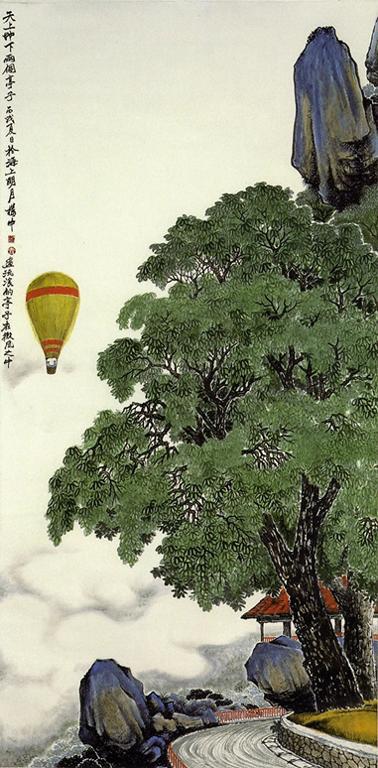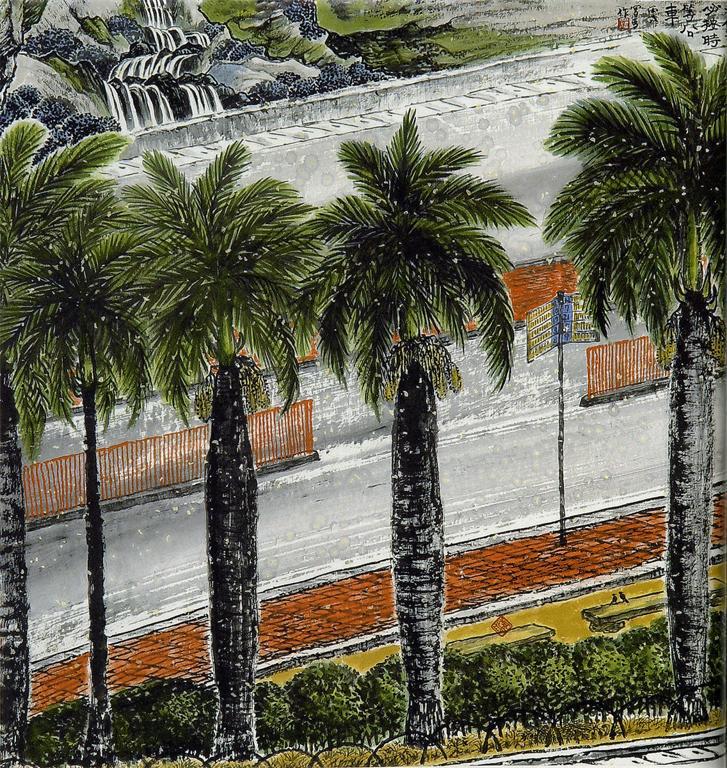The possibilities of flight
"...now the road is built with modern technology, and there is speed. So when you introduce this aspect of roads into landscape painting, how do you show its features? You need to find a helicopter for an aerial view. Then the speed or the power, the distinguishing features of the asphalt road, can be shown. You have new compositions, a new point of view."
-Lo Ch'ing, 2015
The asphalt road is not the only signifier of modernity in Lo Ch'ing's landscape paintings. He also points to human flight as an inspiration for his compositions, allowing him to visualize aerial views of the land below. As we saw in An Eternal Searching, the aerial view flattens the landscape, compressing the narrative into a single, expressive moment. This also reflects the speed of modern vehicles: a car or an airplane can traverse great distances in minutes or hours, passing easily over geographic features that once hindered movement.
Curving between empty, moored boats and a traditional pavilion, the asphalt road undulates across the landscape. Long, parallel brushstrokes create a sense of movement along the road, while shorter, perpendicular strokes indicate joints in the asphalt, a reminder of its human construction. A sea bird hovers over the road, but the viewer floats even higher, soaring forward over and along the asphalt. The road does not disappear over the horizon—it is abruptly cut off by the edge of the painting. This heightens the sense of rapid movement, even as the gaze is drawn back to center by the solitary silhouette of the bird.
We enter this scene in media res, already traveling high in the mountains. Lo Ch’ing juxtaposes action and stillness: a sharply curving asphalt road leads us into the painting and disappears around the mountainside, as if we were traveling rapidly along a mountain road. Before us, we see the otherworldly beauty of a hot-air balloon and a mountainside pavilion. Both seem to float along the side of the mountain, almost motionless. The speed of the road suggests that this pristine view will last only a moment; we will soon pass these two “pavilions” and continue on our unknown journey.
Lo relates the modern hot-air balloon to the traditional pavilion, suggesting that contemporary references can still be symbols of peace and wonder. Road travel sacrifices beauty for speed and efficiency, but the travelers in the balloon rise slowly through the air, experiencing the mountain as if they were clouds themselves.
“And obediently the palm trees stand in line waiting for the cross-town bus.”
–Lo Ch’ing
Here, we see a gentle, humorous approach to a weighty subject. Instead of mankind intruding on nature, this painting depicts nature intruding on mankind. Lo Ch’ing has added a classicizing landscape of mountain streams in the upper left corner of the painting, while the majority of the composition is occupied by a paved bus station and a row of palm trees and shrubbery. Tidy and orderly, these plants resemble humans waiting patiently for a late bus.
At first glance the station appears empty. However, two small birds occupy the right bench. Facing each other they seem to be in conversation. We can easily imagine them as the speakers in the painting’s title: “We have no bus to catch.” With their powers of flight, the birds have no need for human modes of travel. They are not the intended occupants of the bus station and they would not be welcome on a bus. However, they can travel between the borders of civilization and the wilderness on their own volition. They are not bound by the asphalt road; they could fly into the mountain landscape at any moment.

